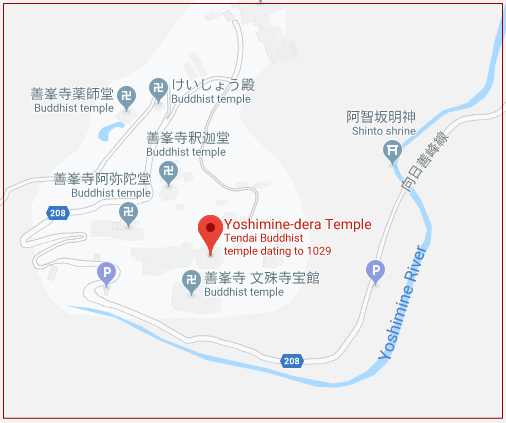Stories of the Temple
One day a Buddhist master called Gensan entered the Nishiyama (lit. West Mountain) mountain range. He was seeking a sanctuary. The mountain path was very steep, and he decided to take a break. While he was resting, a deity in the figure of an old man appeared and said, "This is a sacred place, and I'm the owner. If you build a temple here, I'll give you the land and protect the Buddha dharma forever." So said, he disappeared. It was in 1029, and Gensan was 47 years.
The Master Gensan decided to follow the old man's suggestion. But he faced a big problem. The ground was so rocky and hard that levelling was almost impossible. He was discouraged and frustrated. Then, at that night he had a dream, in which one priest appeared and said he would help him. At the following night, a large herd of wild boars flocked to the site and started flattening the ground. Thanks to boars boring rocks and stones with their tusks, the land was levelled quickly in one night! (It's a story, you know.) The master built a temple on the place and named it Hokkein.
Now the temple built, Master Gensan secluded himself in a cave and started his prayer wishing Buddha teachings would spread among many people. He kept praying. On the seventh day, a demon came and tried to disturb his determination by causing a massive storm. But the master remained firm, in the state of samadhi, with a sword and beads in his hands and the mantra of Mahamayuri in his mouth. Finally, the demon gave in, said it would become a protector of the Buddha dharma and disappeared. This exact spot is dubbed the "Tail of a Demon".
Gensan also performed a rite to invoke rain during droughts. A legend says a blue dragon appeared bringing rain and a shrine for the deity was built on this spot, which has become the shrine for Bezaiten in 1872. By the way, it's said if one begs for rain at the "Tail of a Demon", clouds will immediately come out and pour water (Again, it's just a story!).
From Gorgeous Blossoms to Unknown Wild Flowers
Yes, there are many temples and shrines famous for this and that flowers. But there are a few (except for botanical gardens!) that can really give an impressive catalogue of plants and trees for public viewing. In March, Ume (Japanese apricot) blossoms start the yearly season of flowers. From April to May is the season for Shidare Zakura (Cerasus spachiana), a species of cherry blossom with soft, flexible branches. Then, rhododendrons, peonies and azaleas. In mid-June to early July, twenty species of hydrangeas (total 7000 roots) in blue, light purple and pink magnificently decorate the entire garden measuring 9900 square meters! In August, a 150-year Sarusuberi or crape myrtle blooms. September and October are the time for Shūmei Giku or the Japanese anemone to flourish. In November to early December, trees ablaze with vivid red and yellow leaves. Besides those listed, there are innumerable wild plants and flowers modestly claim their place at corners and roadsides within the temple premises.
Oops! Don't forget to check this. Called Yū Ryū No Matsu, literally meaning "Gliding Dragon Pine Tree", it's a famous 600-year Goyō Matsu (five-needle pine tree). Why the name? If you see this tree from a little far away, it looks like a dragon stretching itself. It measures 37 meters (more than 50 meters before a plant disease in 1994) in length and is listed as a national natural monument.
Another treat for your eye is a seamless, panoramic view of Kyoto City and Mt. Hiei. Breathing pure, refreshing mountainous air through your nostrils, you can enjoy a full spread of the ancient capital. Not so bad for those who want to apply a bird's-eye view to their worldly rush-dash daily lives!
A Kannon Pilgrimage Temple Protected by Emperors
Every temple has its principal image, and that of Yoshimine Temple is Senju Kannon or Avalokitesvara with a thousand arms. The temple is one of Saigoku Sanjū Sanka Sho (the Thirty-three Kannon Pilgrimage Sites in Kanasai) and numbered 20th. As the faith in Kannon became popular, the temple gradually gained prestige. After Emperor Goichijō offered the present temple name, later emperors began to support it. Many imperial family members converted to monks came to live in the temple, and the number of their residences exceeded fifty in the Muromachi Period (1334 - 1573). But the War of Ōnin (1467 to 1477) ruined this prosperity, destroying a significant part of the temple.
It was not until the Edo Period (1603 - 1867) that the temple was restored. A nun named Keishōin, mother of the fifth shogun Tokugawa Tsunayoshi, rebuilt most of the structures, including the Kannon and Homa Halls. The multi-story pagoda, rededicated in 1621 is the oldest kind existing today and has been listed among Japan's Important National Cultural Property. The Atavaka (one of Buddhist Wisdom Kings) image scroll created in the Kamakura Period (1192 - 1333) is also registered in the same list. Two mandalas owned by the temple are specified as cultural assets of Kyoto.
|



